Slow cooked beef cheek, braised in red wine, with vegetables and flavoured with thyme, bay and cinnamon. A hearty, warming stew, perfect for cold Winter days.
Our slow cooked beef cheek is a great tasting winter warming stew. Beef cheek is a cheaper cut of beef, but one that is packed full of flavour. However, despite this, it is a cut of beef that many people are nervous about cooking. Here we show you how easy it is to cook braised beef cheeks at home.

It’s one of those cuts that takes a little time to cook slowly in the oven. The results of this slow braise in the oven are well worth it though. Cooked well, this is one of the tastiest braising cuts that you can buy.
Slow cooked beef cheeks don’t take much in the way of preparation, in fact it’s a straightforward recipe. Sear your meat properly then assemble the remaining ingredients. After that just leave the oven to do all the hard work!
Why you’ll love our slow cooked beef cheek recipe:
- This is comfort food at its best! A rich and warming beef stew that everyone will enjoy.
- Make ahead then pop the dish in the oven to bubble away slowly while you get on with your day.
- Feeding a crowd? No problem, this recipe is easily doubled or trebled.
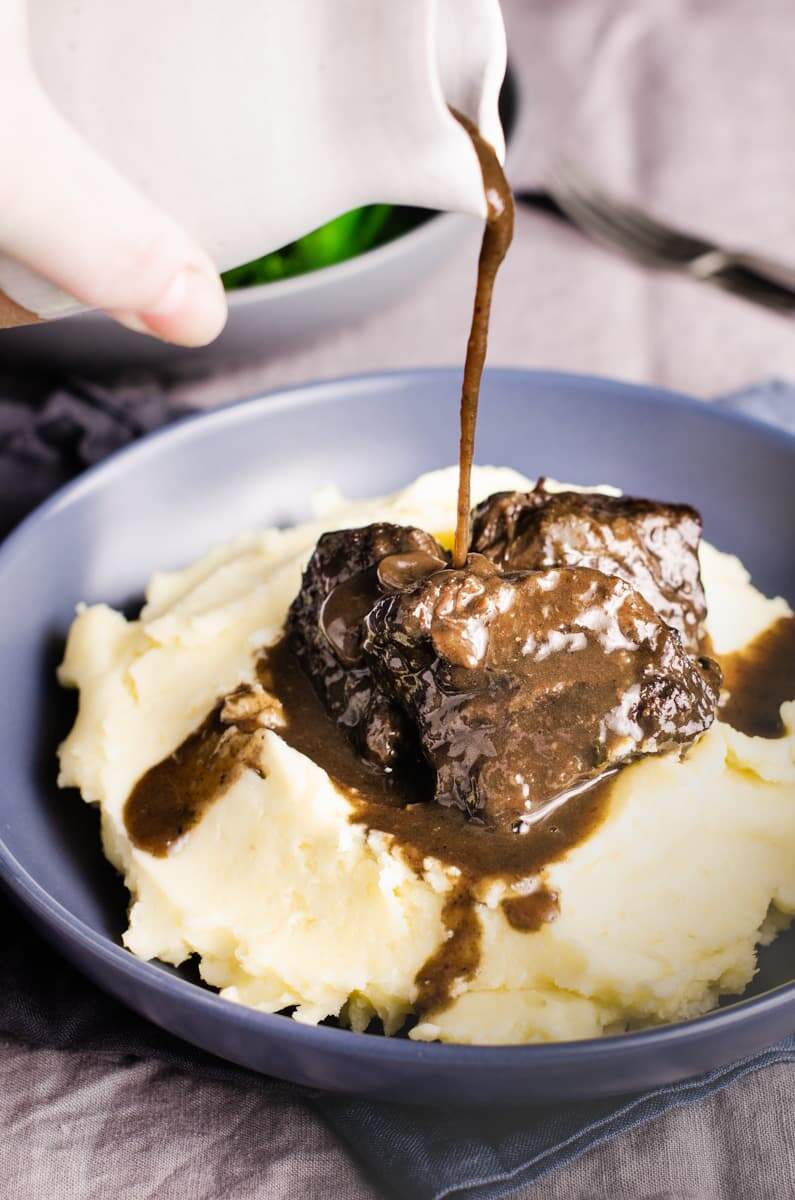
What are beef cheeks good for?
Beef cheek, also called Ox cheek, is simply the cheek muscle of the cow. It is a tough, working muscle and as such requires a little care and attention when cooking. This is not a cut of meat for anyone looking for a quick cook, beef cheeks need long and slow braising at a low temperature.
This is not a difficult dish to prepare, however, time must be given to cook it slowly at a low temperature. By cooking it this way the fat and muscle within the cheek breaks down, leaving a beautifully flavourful, tender piece of meat.
It’s worth pointing out that this is quite a lean cut of beef, therefore not too fatty. Rather it has a really rich, beautiful meaty flavour.
How to braise beef cheeks?
Preparing and searing the beef:
Finishing the braising liquor:
Why are beef cheeks tough?
Beef cheeks will fall apart if cooked correctly. It’s really important to take time preparing the beef cheeks before you start cooking. Trim off excess fat and sinew from around the beef as sinew will not break down during the cook and instead remains tough. Most good butchers will do this for you.
How to avoid chewy beef cheeks?
Our recipe explains step by step how to braise beef cheeks. However, if your beef cheeks are chewy, they simply need to be cooked for longer. Check that you have enough liquid left if the pan and top up with a little beef stock if required. Then place the dish back in the oven and cook for a little longer, checking regularly to stop the beef from drying out.
Recipe substitutions and variations:
- Beef or ox cheek is the meat element of this dish. The best substitute for beef cheeks would be beef short ribs.
- The braising vegetables used in this dish are onion; carrot; celery; chestnut mushrooms; dried mushrooms and garlic. This gives the braising liquor a great flavour, and therefore results in a great tasting gravy. You can’t taste any one vegetable on its own, however if there are any vegetables that you really don’t like then leave them out.
- Fresh parsley, thyme and bay leaves are the herbs we like to use to flavour the dish. You could also add some fresh rosemary.
- A cinnamon stick is added to flavour the beef and the gravy and does not leave this dish feeling overly spiced. Rather the cinnamon adds just a warm hint of mild spicing to the dish.
- Red wine flavours the cooking liquor, we used a Shiraz as it is rich in flavour which in turn enriches the sauce. You could use any other heavy bodied red wine like a Cabernet Sauvignon; Rioja; or Merlot. Just make sure that you cook with a wine that you would actually drink – bad wine will only make the food taste bad!
- Knorr rich beef stock pots are also used to flavour the cooking liquor. These particular stock pots are our favourite to use for this dish as they are really rich and have a depth of beef flavour. You can substitute with any beef stock.
- Apple or blackcurrant jelly or jam is added to finish the gravy as the sweet jelly balances out the savoury flavours in the gravy. You could substitute with a redcurrant jelly.
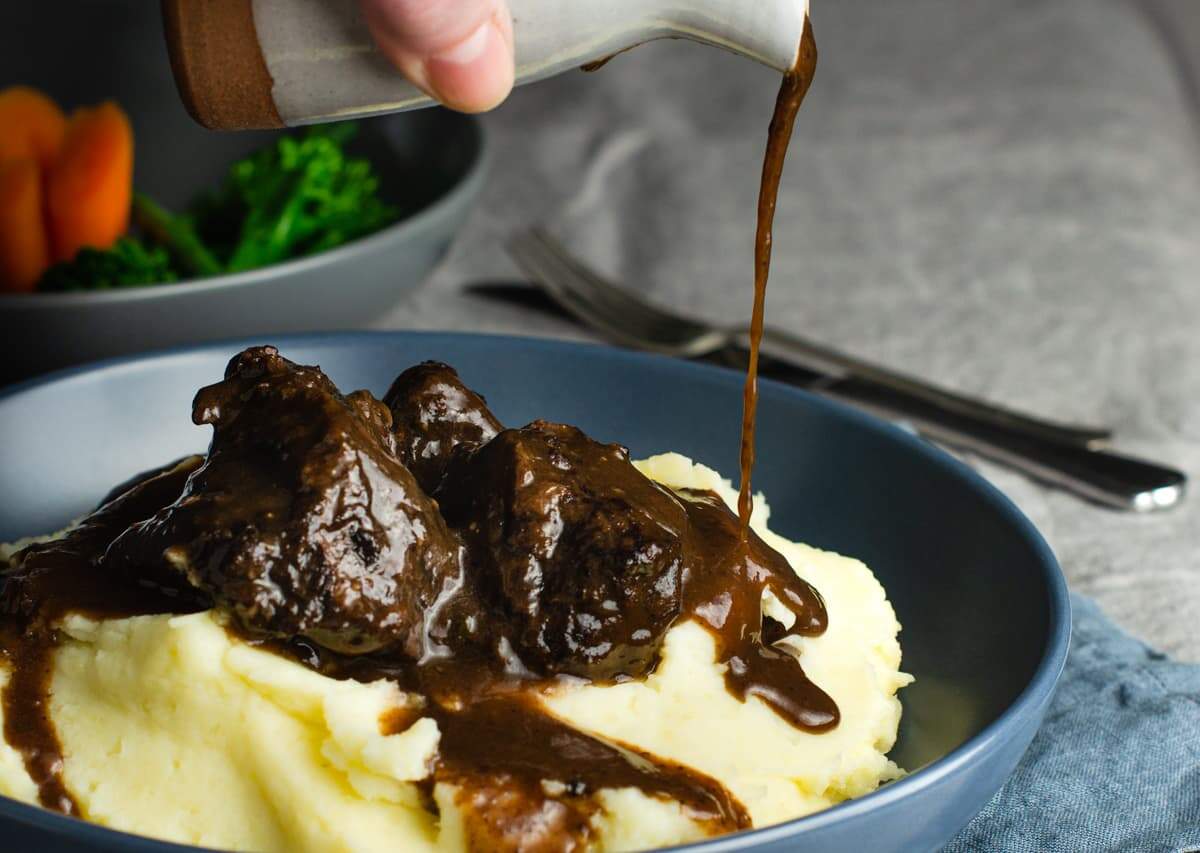
What can I use instead of beef cheeks?
If your butcher doesn’t have beef cheeks, beef short ribs would be a great substitute. Cut the ribs into 250g chunks and they will work a treat in this dish.
You could also use other braising cuts like beef rib trim (a delicious cut from between the ribs) or beef shoulder. However, you would have to adapt the cooking times as these cuts will take less time to cook.
How to braise beef cheeks in the slow cooker?
We have braised our beef cheeks in the oven, however, this is a really simple dish to cook in the slow cooker too. Once you have seared the beef cheeks and vegetables (up to the end of stage 4 in the recipe card) place into the slow cooker along with the remaining ingredients.
Cover the pot with a lid and turn the slow-cooker on low and cook the beef for 8 hours or until the beef is tender. Then once the beef is cooked, remove the beef cheeks from the cooking liquor, discard the braising vegetables and finish the gravy as per the recipe card below. Return the beef cheeks to the gravy and warm through before serving.
Can you prepare beef cheek ahead of time?
This beef cheek stew is best when made a day ahead of when you need it. By cooking it the day before, and allowing it to sit overnight, the flavour of the meat really intensifies and you will have a far better gravy as as result. I find this is true of any meat based stew, it simply tastes better if you can leave it to sit.
Allow the stew to cool, then cover and place in the fridge overnight. When ready to cook, remove from the fridge and bring up to room temperature before heating on the hob or in the oven.
Leftovers can also be stored in the fridge for 2-3 days and heating to piping hot when you are ready to enjoy.
Can I freeze this stew?
As with most beef stews, these braised cheeks freeze really well in their gravy. Simply finish the cook and allow to cool, before spooning into an airtight container and placing into the freezer. Then when you are ready to eat, remove from the freezer and allow to defrost overnight in the fridge. Once frozen this stew will keep for 3 months in the freezer.
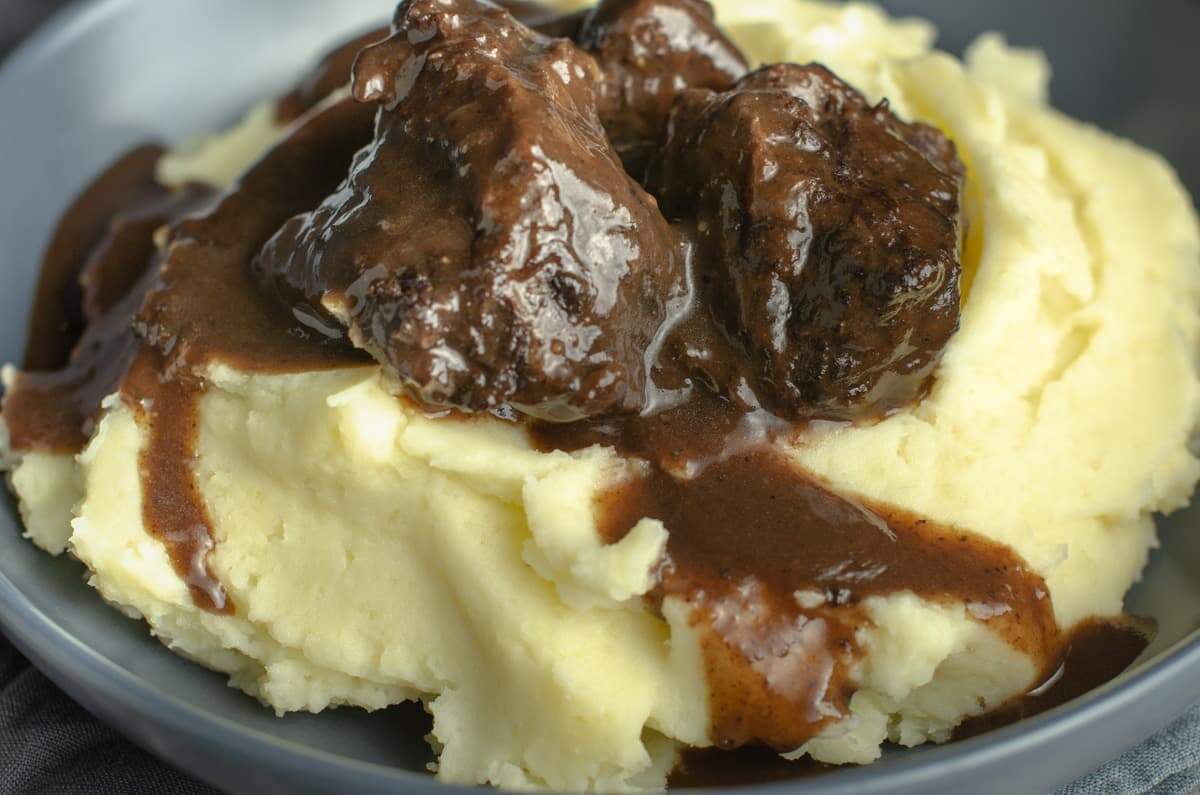
How to serve braised beef cheeks?
This is a deeply flavoured, rich and warming stew so we prefer to serve these braised beef cheeks with some simple vegetable sides, for example broccoli or carrots.
For a potato side we like to serve this dish with buttery mashed potatoes, our Creamy Easy Mustard Mash or our Potato Pave (another great side that can be made ahead of time).
Useful hints and tips:
- Critical step: take your time to properly prepare the beef cheeks, removing the sinew and any excess fat from the cheek (see instructions above). This will result in a superior tasting stew.
- Why do you discard the braising vegetables? This stew cooks for 5 hours, after this length of time the vegetables are really mushy and all the flavour from them has gone into the gravy. They’ve done their job so remove them and finish off the gravy.
- Do not salt the gravy while it is cooking! Other than salting the flour when browning the beef, do not add any additional salt to the braising liquor. The cooking juices are reduced down after the meat has been cooked to form the basis of the gravy. If you add salt before reducing down the juices this can result in an overly salty gravy. Instead finish the gravy and then add salt and more black pepper to balance the taste.
- Equipment: no fancy equipment required, use a Dutch oven with a tight fitting lid, or a deep-based casserole pan with a lid to stew the beef.
- This dish is easily adapted for gluten free diners. Replace the flour with a gluten free plain flour and ensure that the beef stock you are using is also gluten free.
- For dairy free diners simply omit the butter when finishing off the gravy.
- Allergy advice: egg free, soya free and nut free. For comprehensive and detailed allergy advice go to Allergy UK.
Pin the recipe:
Additional recipe suggestions:
If you enjoyed this great tasting Winter warming recipe, then our other slow braised dishes:
Looking for inspiration on feeding the family, then why not have a look at our Ultimate Guide to Family Dinners. This guide is full of recipes, hints and tips to make mealtimes easier.
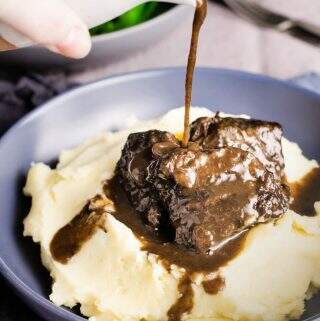
Beef cheek braised in red wine
Ingredients
- 1 kg beef or ox cheek
- 2 tbsp plain flour
- salt & pepper
- 3 tbsp sunflower oil
- 2 onions (chopped)
- 2 carrots (chopped)
- 2 sticks celery (chopped)
- 300 g chestnut mushrooms (sliced)
- 3 cloves garlic (crushed)
- 20 g dried mushrooms (optional)
- 1 large bunch parsley
- 1 small bunch thyme
- 2 bay leaves
- 1 cinnamon stick
- 1 bottle red wine (we used Shiraz)
- 2 Knorr rich beef stock pots
To finish the gravy
- 1 dsp apple or blackcurrant jam/jelly
- 30 g butter
- 30 g plain flour
- salt & pepper
Instructions
- Remove any sinew from the beef cheek and cut into 2-3 large portions. The size will depend largely on the size of the cheek. Don't dice up the cheek. You want to allow a large portion to each diner.
- Place the flour in a shallow plate and season well with salt and pepper. Roll each portion of cheek in the flour and set aside.
- Heat 2 tbsp sunflower oil in a large ovenproof casserole, one with a tight fitting lid. Over a medium heat sear each cut of cheek on all sides. Remove from the pan into a clean plate once brown on all sides. Take care not to add too many to the pan at a time as this will only steam the meat, not brown it.
- Once you have seared all the beef, add the final 1tbsp sunflower oil to the pan. Add in the braising vegetables and cook gently for 5 minutes.
- Add the beef back into the pan, along with the dried mushrooms, fresh herbs, cinnamon stick, red wine and beef stock pots. Add a good crack of black pepper and stir well. Do not add any salt at this point as this will result in a salty stew when you come to reducing the cooking liquor for making the gravy.
- Cover the casserole with a lid and place in the oven at 140CFan for 5 hours. During this time remove the casserole a couple of times to give it a mix and push the beef cheek down into the braising liquor.
- After 5 hours remove the casserole from the oven, allow it to cool and if time permits, pop it into the fridge overnight. This really improves the flavour of the meat.
To finish the gravy
- When you are ready to serve the beef cheek, bring it gently up to a low heat. Remove the portions of cheek from the pan and set aside on a plate.
- Next place a sieve over a large, clean saucepan. Gently pour the gravy through the sieve, allowing the sieve to catch all the vegetables. Leave to drain for 15 minutes as you want to save as much gravy as you can. Discard the vegetables.
- Place the gravy saucepan over a high heat and bring to the boil. Once boiling, cook the gravy until you have reduced it by half. By this time the grave will have thickened a little. Stir through the apple or blackcurrant jelly/jam.
- In a small non-stick saucepan, melt the butter over a medium heat and add the flour. Stir to combine into a roux. Continue to cook the roux for 5 minutes to cook out the flour, stirring continuously to avoid burning.
- Now add the flour roux to the gravy and whisk quickly to avoid lumps from forming. Once combined pass the gravy through the sieve one last time to remove any lumps that may have formed from either the roux or jam.
- Taste the gravy for seasoning, adding salt and pepper. Return the beef cheek portions to the pan and heat up gently before serving.
Notes
• Please note that the nutrition information provided above is approximate and meant as a guideline only •
We’ve linked this recipe up to CookBlogShare, click on the link to find recipes by fellow food bloggers.

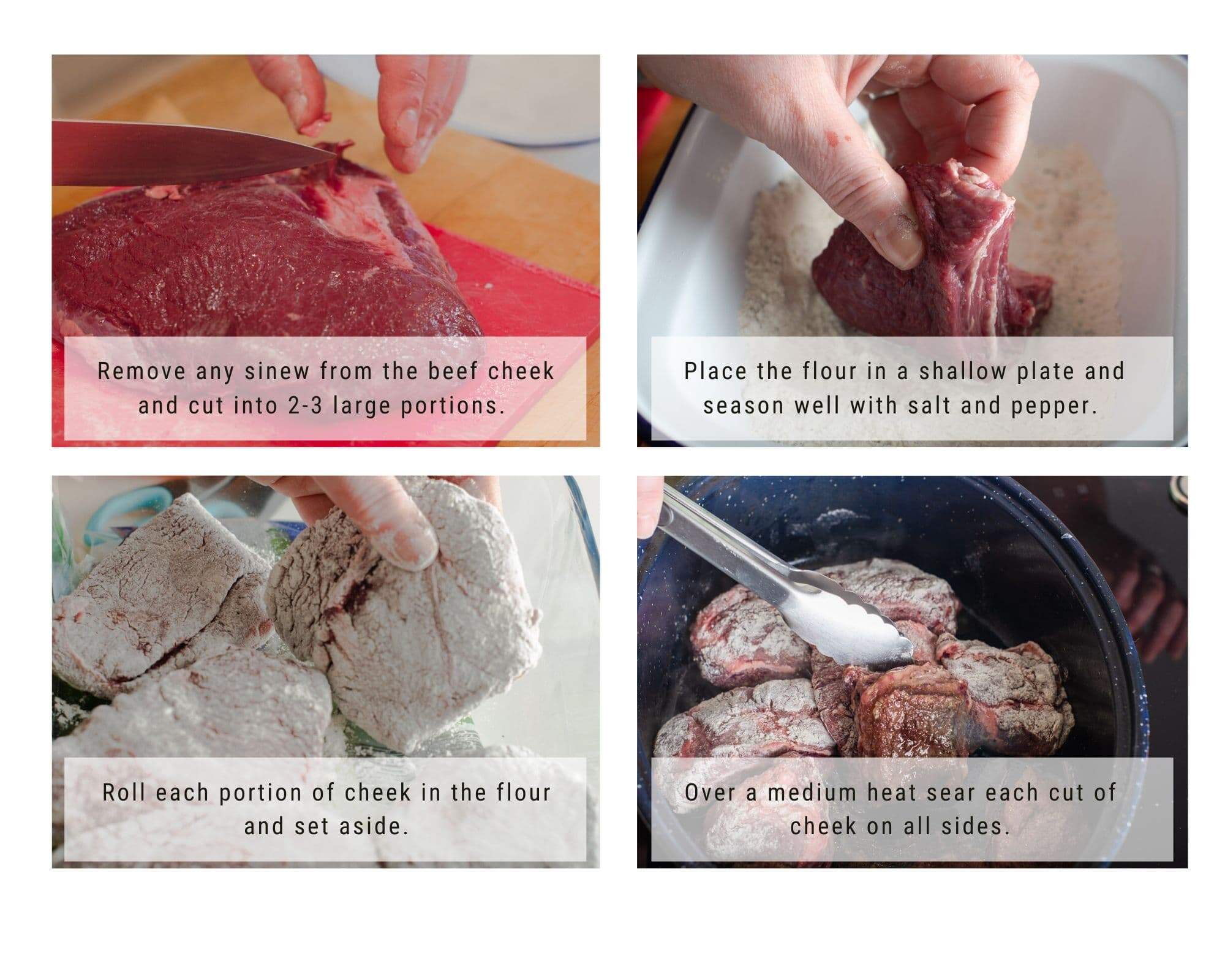
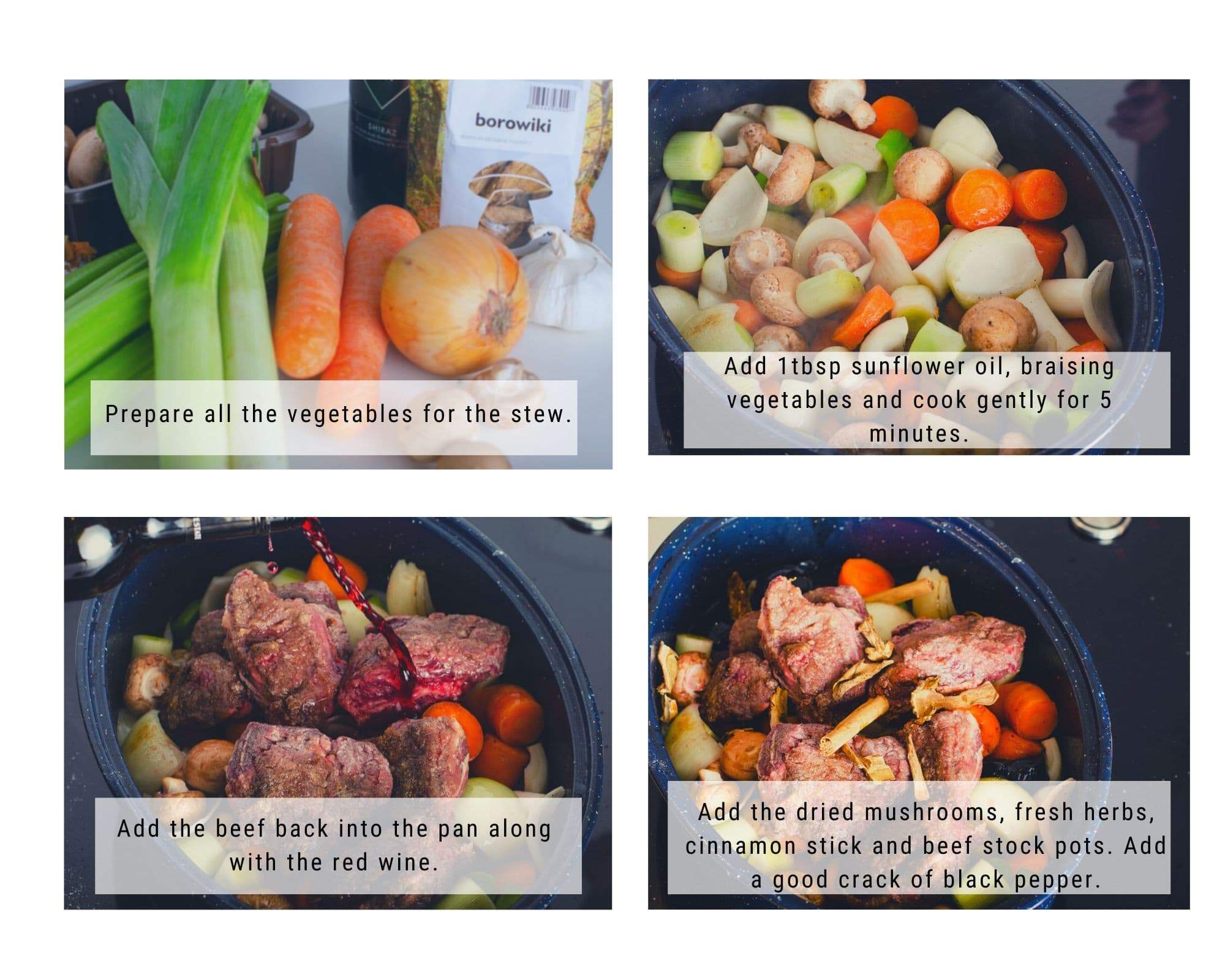
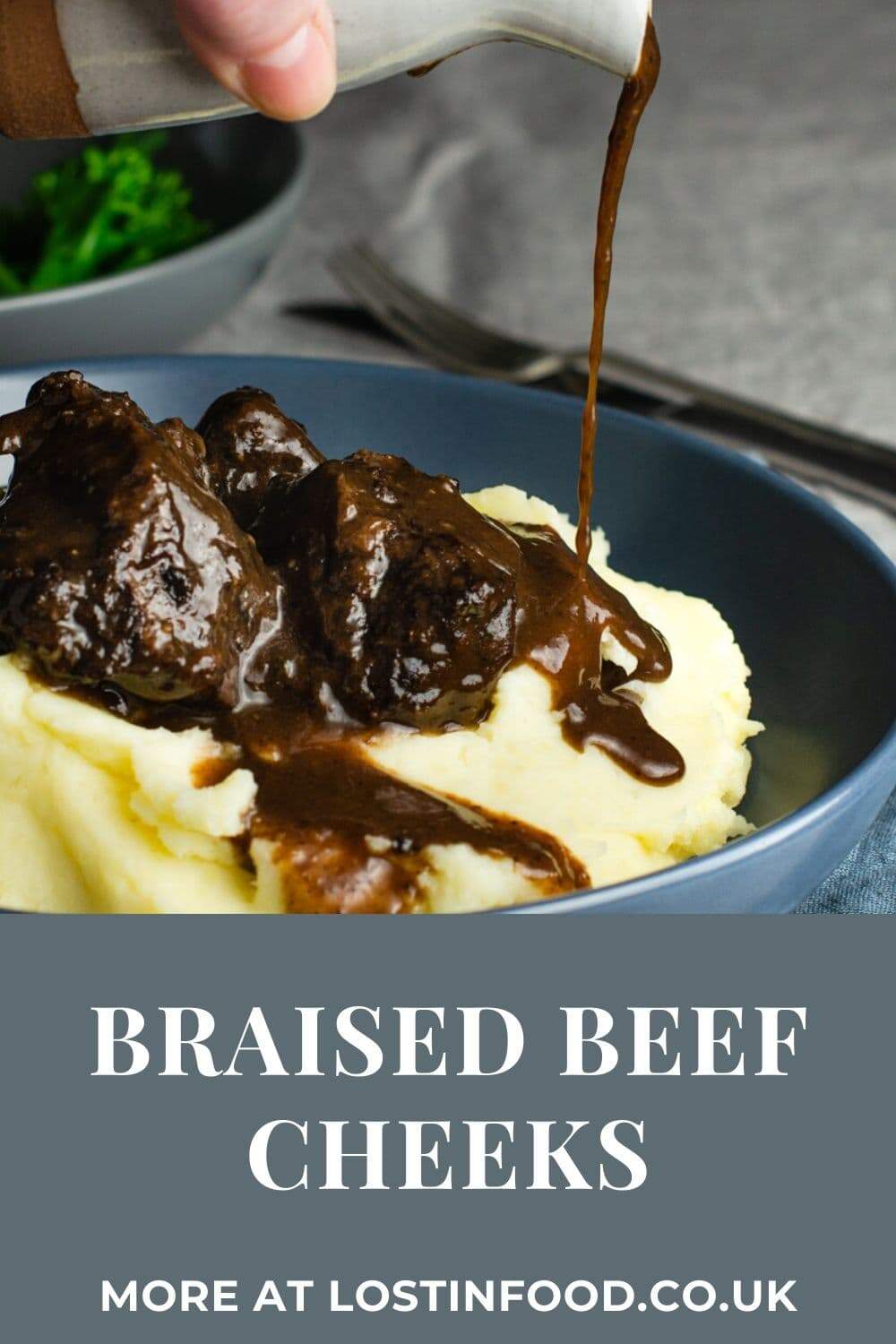
Lou Gunstone
Friday 13th of March 2020
Great post. Love beef cheeks and as you say they are perfect for slow cooking... which makes life so simple :)
Lesley
Saturday 14th of March 2020
Thank you Jo, this dish looks to have a lot of ingredients, but it really is a case of popping it all in a pan and then leaving it to cook away in a low oven. Impressively easy. Lesley x
Eb Gargano | Easy Peasy Foodie
Tuesday 25th of February 2020
Wow - this just looks incredible. I love slow cooked beef - and especially if it has a red wine sauce. In fact, any meal which uses a whole bottle of wine is a winner for me :-D Eb x
Lesley
Tuesday 25th of February 2020
Thank you Eb, I couldn't agree more, I love slow cooked beef. It went down really well with diners at our recent Supperclubs. Lesley x
Cat | Curly's Cooking
Monday 24th of February 2020
This looks incredibly delicious. I'm pinning this to make the next time I see beef cheeks! It looks so comforting.
Lesley
Tuesday 25th of February 2020
Thank you Cat. Although it's a lengthy cook, it's a very simple one. The oven really does all the hard work. Lesley x
Louise Fairweather
Monday 24th of February 2020
This is not a cut I have really used. Looks lovely. Thanks for sharing
Lesley
Tuesday 25th of February 2020
Thank you Louise, it's such a simple cut to cook with. It takes a long time to break down but is so full of flavour. Lesley x